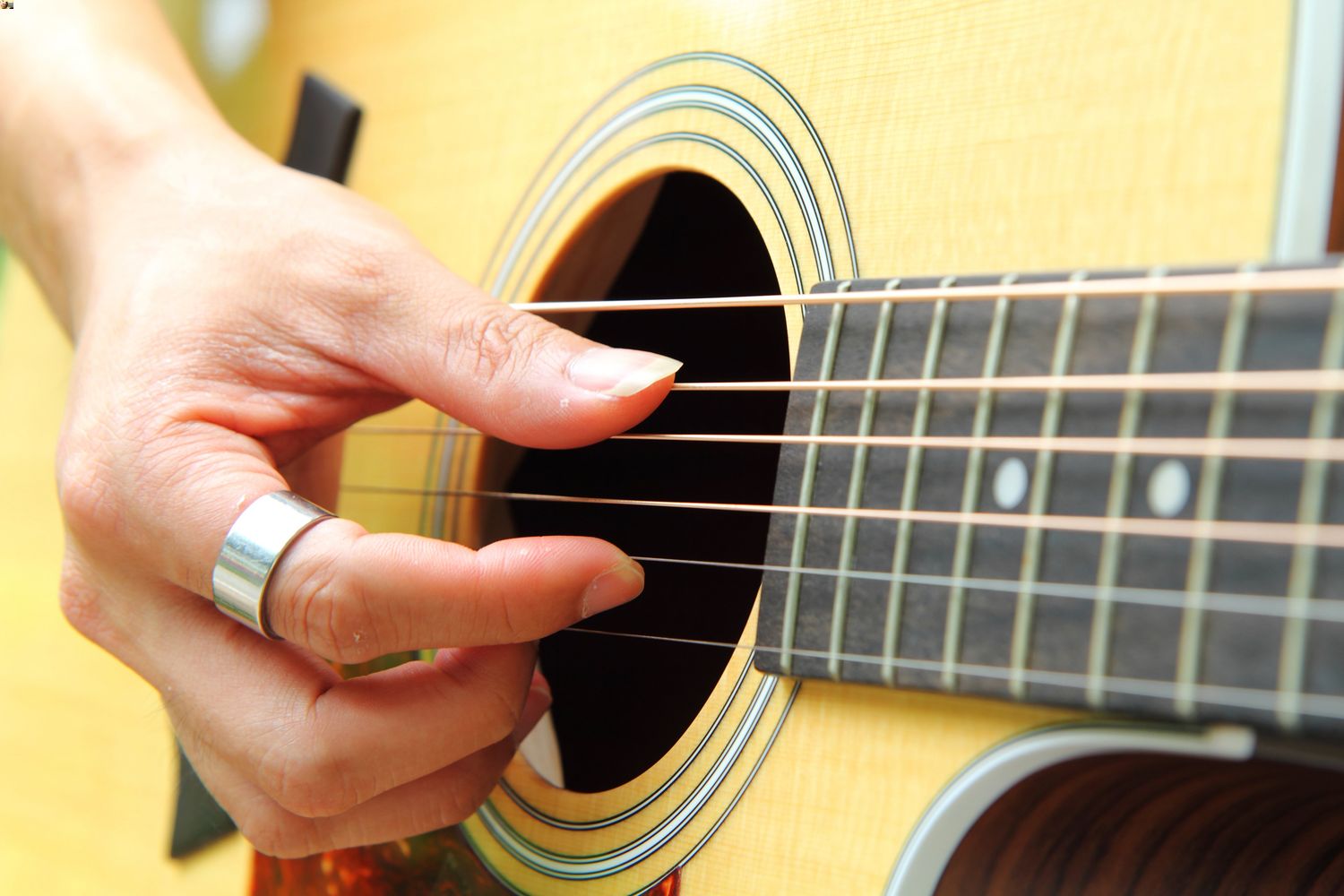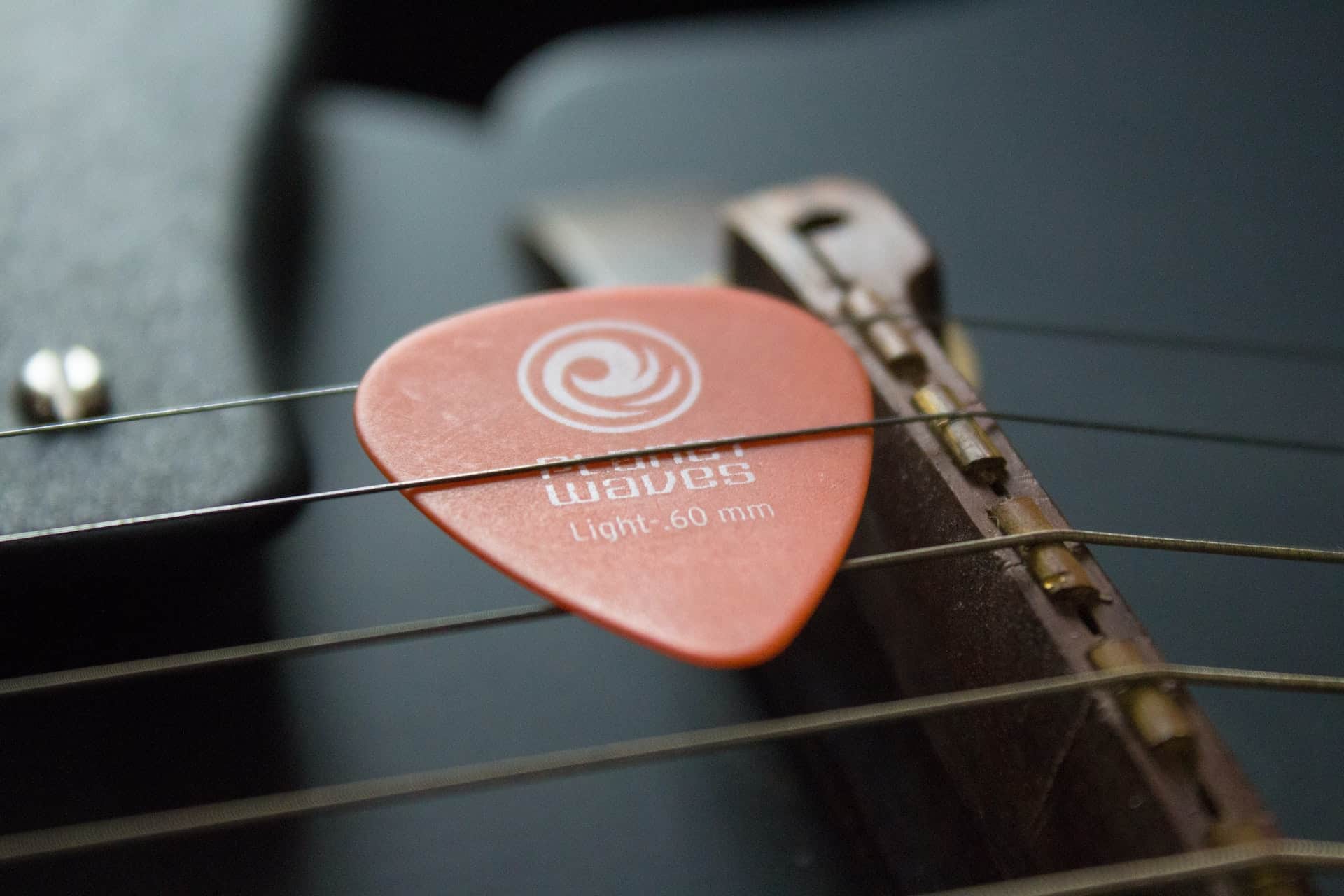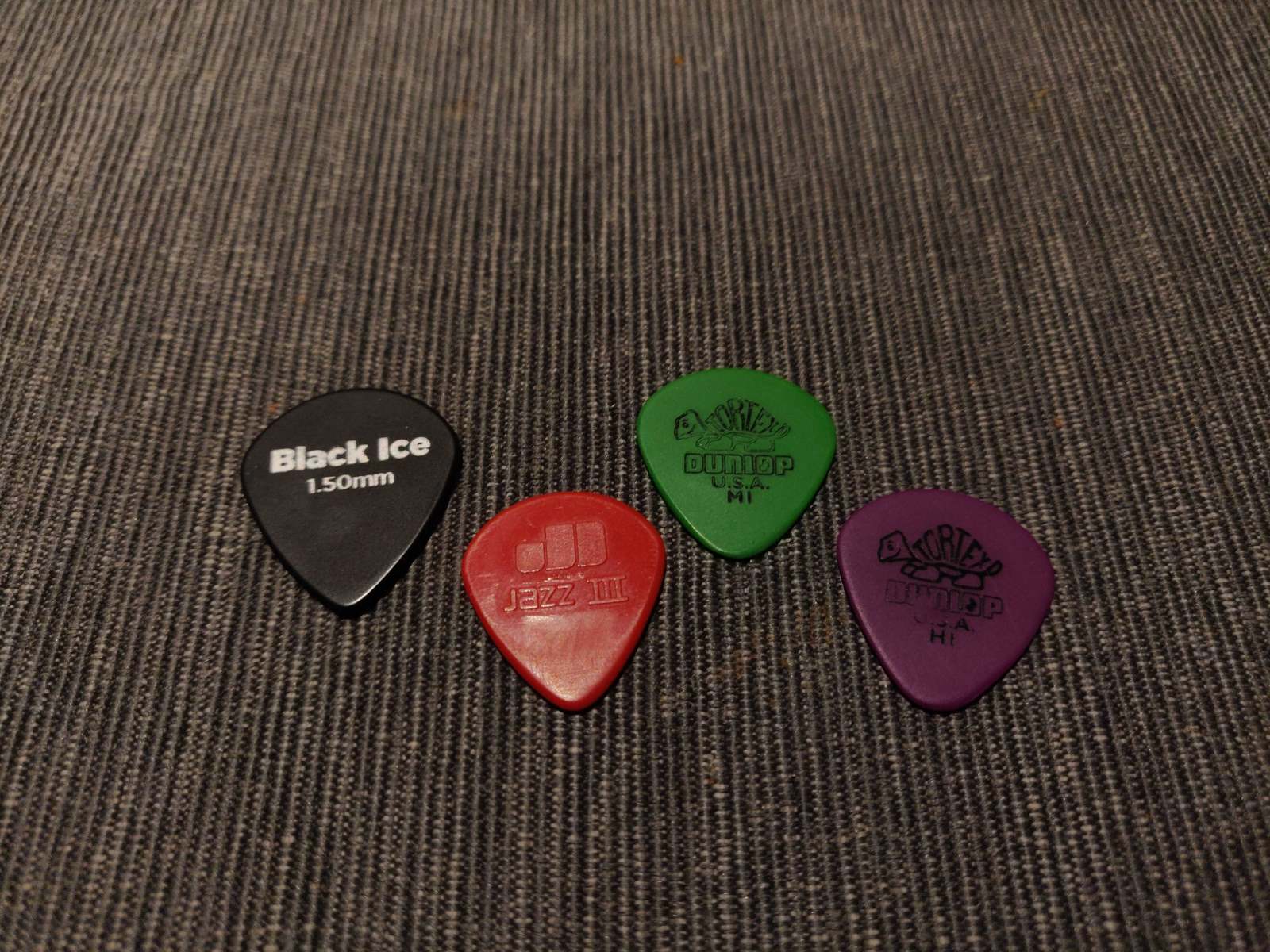Home>Instruments>Guitar>How To Finger Pick A Guitar


Guitar
How To Finger Pick A Guitar
Published: February 12, 2024
Learn the art of fingerpicking a guitar with our step-by-step guide. Master the techniques and elevate your guitar playing skills today!
(Many of the links in this article redirect to a specific reviewed product. Your purchase of these products through affiliate links helps to generate commission for AudioLover.com, at no extra cost. Learn more)
Table of Contents
Introduction
Learning to finger pick a guitar is a skill that opens up a world of musical possibilities. Unlike strumming with a pick, finger picking allows for greater control and expression, enabling the guitarist to create intricate melodies, harmonies, and rhythms. Whether you're drawn to the soulful sounds of folk and blues or the complex arrangements of classical and flamenco music, mastering finger picking can elevate your playing to new heights.
Finger picking, also known as fingerstyle guitar, involves plucking the strings with the fingertips or fingernails of the picking hand, producing a rich and nuanced sound. This technique is favored by legendary guitarists such as Chet Atkins, Merle Travis, and Tommy Emmanuel, whose mesmerizing performances showcase the artistry and versatility of fingerstyle playing.
In this comprehensive guide, we will delve into the art of finger picking, exploring fundamental techniques, essential exercises, and valuable tips for honing your skills. Whether you're a beginner eager to embark on your fingerstyle journey or an experienced player seeking to refine your technique, this guide will equip you with the knowledge and tools to unlock the captivating world of fingerstyle guitar.
From understanding the mechanics of finger picking to selecting the right finger picks and mastering dexterous exercises, each aspect of this guide is designed to empower you on your fingerstyle guitar odyssey. So, grab your guitar, get comfortable, and let's embark on a melodic adventure through the enchanting realm of finger picking.
Understanding Finger Picking
At its core, finger picking involves using the individual fingers of the picking hand to pluck the strings of the guitar. This technique offers a level of dexterity and control that is unparalleled, allowing guitarists to produce intricate melodies, complex chord progressions, and rhythmic patterns with remarkable precision. Unlike strumming, which tends to create a uniform sound, finger picking enables the player to evoke a wide range of tones and dynamics, lending depth and expressiveness to their music.
One of the defining characteristics of fingerstyle guitar is the ability to play multiple parts simultaneously. This means that the guitarist can create a bassline, melody, and harmony all within a single composition, resulting in a rich and layered sound. This versatility is particularly evident in genres like folk, blues, and classical music, where fingerstyle playing is integral to the distinctive sound of the genre.
When approaching finger picking, it’s essential to understand the role of each finger in producing different tones and textures. Typically, the thumb is responsible for plucking the lower three strings (E, A, D) of the guitar, producing a warm and resonant bassline. Meanwhile, the index, middle, and ring fingers are employed to pluck the higher strings (G, B, E), facilitating the creation of melodies and harmonies.
Furthermore, fingerstyle guitarists often utilize techniques such as arpeggios, where the individual notes of a chord are played in succession, and finger rolls, which involve rapidly plucking adjacent strings to create a cascading effect. These techniques, along with others like hammer-ons, pull-offs, and slides, contribute to the nuanced and expressive nature of fingerstyle playing.
Understanding the intricacies of finger picking lays the foundation for developing a strong and versatile technique. By honing this skill, guitarists can unlock a world of musical possibilities, allowing them to breathe life into their compositions and captivate audiences with the emotive power of fingerstyle guitar.
Basic Finger Picking Techniques
Mastering basic finger picking techniques is essential for anyone looking to delve into the captivating world of fingerstyle guitar. These fundamental techniques form the building blocks upon which more intricate and advanced skills are developed. Whether you’re a novice seeking to establish a strong foundation or an experienced player aiming to refine your approach, understanding and practicing these techniques is key to unlocking the expressive potential of fingerstyle playing.
1. Thumb-Index Alternation: This foundational technique involves alternating between the thumb and index finger to pluck individual strings. The thumb typically handles the bass notes, while the index finger is responsible for the higher strings. Practicing this alternation pattern helps develop coordination and control, laying the groundwork for more complex fingerstyle patterns.
2. Basic Arpeggios: Arpeggios involve plucking the individual notes of a chord in a specific sequence, creating a flowing and melodic effect. Common patterns include the PIMA pattern, where the thumb (P) plucks the bass note, followed by the index (I), middle (M), and ring (A) fingers playing the higher strings in succession. Arpeggios are integral to fingerstyle playing and are employed across various musical genres.
3. Finger Independence Exercises: Developing finger independence is crucial for executing intricate fingerstyle arrangements. This involves practicing exercises that focus on strengthening and coordinating the movements of each finger. Simple exercises, such as sequential plucking of individual strings with each finger, can significantly enhance dexterity and control.
4. Thumb-Thumb-Index Pattern: This pattern involves the thumb plucking two consecutive bass notes followed by the index finger plucking a higher string. It is commonly used in blues and folk fingerstyle playing, adding rhythmic drive and melodic interest to the music.
5. Travis Picking: Named after the legendary guitarist Merle Travis, this technique involves a syncopated thumb pattern combined with melody notes played by the fingers. Travis picking is a hallmark of country and folk guitar styles, characterized by its lively and rhythmic sound.
By familiarizing yourself with these basic finger picking techniques and dedicating time to deliberate practice, you can lay a solid groundwork for exploring the boundless creativity and expression that fingerstyle guitar offers.
Choosing the Right Finger Picks
When it comes to fingerstyle guitar playing, selecting the right finger picks is crucial for achieving the desired tone, comfort, and control. Finger picks, also known as fingerpicks, are small plectrums that fit over the fingertips, enhancing the guitarist’s ability to pluck the strings with precision and clarity. They come in various materials, shapes, and sizes, each offering distinct advantages and characteristics.
1. Metal Finger Picks: Metal finger picks, often made of stainless steel or nickel silver, provide a bright and articulate sound. They are favored by many fingerstyle guitarists for their durability and ability to produce clear, defined notes. Metal picks can be adjusted to fit the individual’s finger size and playing style, making them a versatile choice for a wide range of genres.
2. Plastic Finger Picks: Plastic finger picks, typically made of celluloid or other durable plastics, offer a warmer and mellower tone compared to metal picks. They are lightweight and comfortable to wear, making them suitable for extended playing sessions. Plastic picks are popular among acoustic guitarists exploring folk, country, and blues styles.
3. Fingerstyle Thumb Picks: In addition to finger picks, thumb picks are essential for fingerstyle guitarists who prefer using their thumb for bass notes and rhythmic patterns. Thumb picks come in various shapes and materials, allowing players to customize their tone and playing experience. Many thumb picks feature an adjustable band that wraps around the thumb, providing a secure fit during performance.
When choosing finger picks, it’s important to consider factors such as comfort, responsiveness, and the desired tonal characteristics. Experimenting with different types of finger picks can help you find the ideal combination that complements your playing style and enhances your overall fingerstyle guitar experience.
Ultimately, the right finger picks should feel like a natural extension of your fingers, empowering you to execute intricate patterns and express your musical ideas with confidence and clarity. Whether you prefer the bright attack of metal picks or the warmth of plastic picks, the perfect set of finger picks can elevate your fingerstyle playing to new heights.
Exercises for Finger Picking
Developing dexterity, coordination, and precision is essential for mastering fingerstyle guitar playing. Engaging in targeted exercises can significantly enhance your finger picking technique, allowing you to navigate complex patterns and expressively interpret musical compositions. These exercises are designed to strengthen the fingers, improve finger independence, and refine your ability to pluck the strings with control and finesse.
1. Thumb-Index Alternation Drills: Begin by practicing the fundamental thumb-index alternation pattern, focusing on maintaining a steady rhythm and consistent tone. Start with simple chord progressions and gradually increase the complexity as your comfort and proficiency grow.
2. Arpeggio Patterns: Dedicate time to practicing arpeggios using various chord shapes. Focus on producing even and clear notes, paying attention to the balance between the bass notes plucked by the thumb and the melody notes played by the fingers. Experiment with different arpeggio patterns to expand your musical vocabulary.
3. Finger Independence Exercises: Engage in exercises that target the independence and strength of each finger. This can include practicing scales, chromatic passages, and sequences that challenge the coordination of your fingers, ultimately enhancing your ability to execute intricate fingerstyle arrangements.
4. Rhythmic Fingerstyle Patterns: Explore rhythmic patterns such as the thumb-thumb-index pattern and Travis picking to develop a strong sense of groove and timing. Emphasize the interplay between the thumb and fingers to create compelling rhythmic textures.
5. Dynamic Control Exercises: Work on exercises that focus on dynamics, allowing you to explore the full range of expression in your playing. Practice gradually increasing and decreasing the volume of individual notes and chords, honing your ability to infuse your music with emotion and nuance.
Consistent and focused practice of these exercises will not only strengthen your fingerstyle technique but also cultivate a deep understanding of the expressive potential inherent in fingerstyle guitar playing. By integrating these exercises into your practice routine, you can embark on a rewarding journey of musical growth and artistic exploration.
Tips for Improving Finger Picking
Refining your finger picking technique is a continuous journey that requires dedication, patience, and a mindful approach to practice. Whether you’re just beginning to explore fingerstyle guitar or seeking to elevate your existing skills, incorporating the following tips into your practice routine can significantly enhance your finger picking proficiency and musical expression.
1. Focus on Relaxation: Maintain a relaxed and natural hand position while finger picking. Tension can impede your dexterity and control, so strive to keep your fingers and hand muscles loose and supple during playing. Regular stretching exercises can help alleviate tension and promote flexibility.
2. Use a Metronome: Practicing with a metronome is invaluable for developing a steady sense of rhythm and timing. Start at a comfortable tempo and gradually increase the speed as you become more proficient. Consistent rhythmic precision is essential for compelling fingerstyle playing.
3. Focus on Tone: Pay attention to the tone and dynamics of your playing. Experiment with different plucking angles, finger positions, and levels of attack to produce a diverse range of tones. Strive for clarity and expressiveness in each note you play.
4. Record and Listen: Record your practice sessions and performances to gain valuable insight into your progress. Listening to recordings allows you to identify areas for improvement, refine your musical interpretations, and track your development over time.
5. Explore Various Styles: Embrace a diverse repertoire of fingerstyle music, spanning genres such as blues, folk, classical, and jazz. Each style offers unique challenges and techniques, broadening your musical vocabulary and expanding your creative horizons.
6. Seek Inspiration from Masters: Study the playing styles of renowned fingerstyle guitarists, drawing inspiration from their phrasing, dynamics, and emotive expression. Analyzing their performances can provide valuable insights and ignite your own creativity.
7. Experiment with Open Tunings: Explore alternate guitar tunings to unlock new harmonic possibilities and enrich your fingerstyle arrangements. Open tunings can inspire fresh ideas and expand the sonic palette available to you as a fingerstyle guitarist.
By integrating these tips into your practice regimen and approaching your fingerstyle journey with curiosity and determination, you can cultivate a nuanced and compelling approach to finger picking. Embrace the process of continuous improvement, and allow your passion for fingerstyle guitar to propel you toward greater musical heights.
Conclusion
Congratulations on embarking on the enriching journey of fingerstyle guitar playing. Throughout this guide, we’ve explored the artistry, techniques, and essential elements that define the captivating realm of finger picking. From understanding the mechanics of fingerstyle guitar to honing foundational techniques and selecting the right gear, each aspect contributes to the holistic development of your fingerstyle playing.
As you delve into the world of fingerstyle guitar, remember that patience, persistence, and a spirit of exploration are your greatest allies. Embrace the process of learning and allow yourself the freedom to experiment, make mistakes, and grow as a musician. By integrating targeted exercises, refining your technique, and seeking inspiration from diverse musical styles, you can cultivate a rich and expressive approach to fingerstyle playing.
Whether you aspire to evoke the soulful sounds of blues, the intricate melodies of folk, or the timeless compositions of classical music, fingerstyle guitar offers a boundless canvas for artistic expression. Your journey as a fingerstyle guitarist is a deeply personal and rewarding pursuit, allowing you to infuse your musical voice with emotion, creativity, and a profound connection to the instrument.
As you continue to refine your finger picking technique, remember that the true essence of fingerstyle guitar lies in the ability to convey stories, emotions, and experiences through the strings of your instrument. Let your passion for music guide you, and allow the mesmerizing world of fingerstyle guitar to unfold as a source of joy, inspiration, and boundless creativity.
So, pick up your guitar, let your fingers dance across the strings, and embark on a melodic odyssey through the enchanting realm of finger picking. With dedication and a love for the craft, you’ll discover a world of musical possibilities waiting to be explored.











